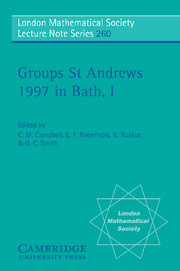Book contents
- Frontmatter
- Contents
- Contents of Volume II
- Introduction
- Radical rings and products of groups
- Homogeneous integral table algebras of degrees two, three and four with a faithful element
- A polynomial-time theory of black box groups I
- Totally and mutually permutable products of finite groups
- Ends and algebraic directions of pseudogroups
- On locally nilpotent groups with the minimal condition on centralizers
- Infinite groups in projective and symplectic geometry
- Non-positive curvature in group theory
- Group-theoretic applications of non-commutative toric geometry
- Theorems of Kegel-Wielandt type
- Singly generated radicals associated with varieties of groups
- The word problem in groups of cohomological dimension
- Polycyclic-by-finite groups: from affine to polynomial structures
- On groups with rank restrictions on subgroups
- On distances of multiplication tables of groups
- The Dade conjecture for the McLaughlin group
- Automorphism groups of certain non-quasiprimitive almost simple graphs
- Subgroups of the upper-triangular matrix group with maximal derived length and a minimal number of generators
- On p-pronormal subgroups of finite p-soluble groups
- On the system of defining relations and the Schur multiplier of periodic groups generated by finite automata
- On the dimension of groups acting on buildings
- Dade's conjecture for the simple Higman-Sims group
- On the F*-theorem
- Covering numbers for groups
- Characterizing subnormally closed formations
- Symmetric words in a free nilpotent group of class 5
- A non-residually finite square of finite groups
Ends and algebraic directions of pseudogroups
Published online by Cambridge University Press: 05 August 2013
- Frontmatter
- Contents
- Contents of Volume II
- Introduction
- Radical rings and products of groups
- Homogeneous integral table algebras of degrees two, three and four with a faithful element
- A polynomial-time theory of black box groups I
- Totally and mutually permutable products of finite groups
- Ends and algebraic directions of pseudogroups
- On locally nilpotent groups with the minimal condition on centralizers
- Infinite groups in projective and symplectic geometry
- Non-positive curvature in group theory
- Group-theoretic applications of non-commutative toric geometry
- Theorems of Kegel-Wielandt type
- Singly generated radicals associated with varieties of groups
- The word problem in groups of cohomological dimension
- Polycyclic-by-finite groups: from affine to polynomial structures
- On groups with rank restrictions on subgroups
- On distances of multiplication tables of groups
- The Dade conjecture for the McLaughlin group
- Automorphism groups of certain non-quasiprimitive almost simple graphs
- Subgroups of the upper-triangular matrix group with maximal derived length and a minimal number of generators
- On p-pronormal subgroups of finite p-soluble groups
- On the system of defining relations and the Schur multiplier of periodic groups generated by finite automata
- On the dimension of groups acting on buildings
- Dade's conjecture for the simple Higman-Sims group
- On the F*-theorem
- Covering numbers for groups
- Characterizing subnormally closed formations
- Symmetric words in a free nilpotent group of class 5
- A non-residually finite square of finite groups
Summary
Abstract
The notion of an end of a group is generalised to the case of finitely generated pseudogroups. The notion of a direction of a pseudogroup, subtler than the end of a pseudogroup, is introduced in this paper. The ends and directions of the Markov pseudogroup are described.
Introduction
The notion of an end of a group was originated in the 40's by H. Freudenthal [Fre] and H. Hopf [Hop]. A classical result of H. Hopf [Hop] says that the end space E(X) of a connected topological space X is an invariant of the group G of covering transformations. Thus it becomes meaningful to define the end space of the finitely generated group G as E(G) ≔ E(X).
The notion of the end of a group was studied again by J. Stailings [Sta] and D. Cohen [Cohl], [Coh2] in the 70's. D. Cohen has used a combinatorial method to define the number of ends of an arbitrary group G. The end spaces of finitely generated groups were completely classified (see [Coh2], [Hop], [Sta]).
The theory of ends of groups was generalised. A more general concept, introduced by C. Hougton [Hou] and further explored by G. Scott [Sco] and M. Sageev [Sag], is the number of a group G relative to a subgroup H.
- Type
- Chapter
- Information
- Groups St Andrews 1997 in Bath , pp. 69 - 80Publisher: Cambridge University PressPrint publication year: 1999



